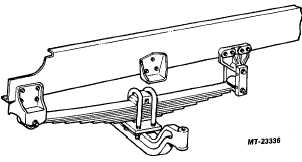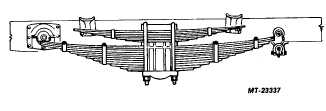|
| |
TRUCK SERVICE MANUAL
TM 5-4210-230-14&P-1
SPRING ASSEMBLIES
DESCRIPTION
Constant Rate
Constant
rate
springs
are
leaf-type
spring
assemblies that have a constant rate of deflection. For
example, if 227 Kg (500 lbs.) deflect the spring
assembly 2.54 cm (1 in.), then 454 Kg (1000 lbs.) would
deflect the same spring assembly 5.08 cm (2 in.). Thus,
the rate of deflection is constant.
Constant rate springs are mounted to the axle with
U-bolts, nuts and lock washers. The front end of the
spring is mounted to a stationary bracket while the rear
end of the spring is mounted to a spring shackle. The
shackle allows for variations in spring length during
compression and rebound of the spring.
This type of spring assembly is used in both front
and rear axle applications on IH vehicles.
Figs. 1 and 2 show typical views of constant rate spring
assembly applications.
Fig. 1 Front Axle Application (Constant Rate)
Fig. 2 Rear Axle Application (Constant Rate)
Taper Leaf
Taper leaf springs are leaf type spring assemblies that
have spring leafs which are thicker in the center than the
ends. This design results in a fewer number of leafs
which provides lighter weight and softer ride due to
lower inner leaf friction.
Taper leaf springs are mounted to the axle with U-
bolts, nuts and lock washers. The front end of the
spring is mounted to a stationary bracket while the rear
end of the spring is mounted to a spring shackle. The
shackle allows for variations in spring length during
compression and rebound of the spring.
Taper leaf spring assemblies are used on front
axles only. Figure 3 illustrates a Taper leaf assembly.
Fig. 3 Taper Leaf Spring Assembly
Auxiliary Springs
Auxiliary springs are leaf-type spring assemblies
usually mounted on top of the vehicle rear spring
assemblies. Auxiliary springs are only used when the
vehicle is under heavy load. The auxiliary spring
assumes part of the load by contacting special brackets
attached to frame rail slides when the load is sufficient
to compress the vehicle rear spring assemblies to the
point of contact.
Fig. 4 illustrates an auxiliary spring assembly.
Fig.4 Auxiliary Spring Assembly
Progressive (Vari-Rate)
Progressive (Vari-rate) springs are leaftype spring
assemblies with a variable deflection rate obtained by
varying the effective length of the spring assembly.
This is accomplished by using a cam-type bracket. As
the spring assembly deflects, the point of contact on the
bracket moves toward the center of the spring assembly
shortening the effective length, Figure 5.
Vari-rate spring assemblies also incorporate a
progressive feature in that the bottom spring leaves are
separated at the ends.
CTS-2680S Chapter I Page 3
PRINTED IN UNITED STATES OF AMERICA
|




